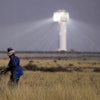When the West Indian manatee was listed as endangered in 1967, fewer than 1,000 of the creatures were known to be in Florida waters. But by then the species had also found a safe haven in the most unlikely of places: the warm waters near local power stations.
For more than 70 years, they have been flocking to the heated waters created by discharge from Florida power plants to float out colder months. Because manatees can’t survive in waters colder than 68 degrees Fahrenheit, those who don’t make it to either power plant waters or local springs often die.
Yet, the discovery of power plants has helped the manatee population boom. Today there are as many as 6,300 in Florida and they no longer qualify as endangered. Around 60 percent of the state’s manatees rely on the warm water refuge outside power plants and the yearly phenomena draws so many manatees, one power station in Tampa even has a “Manatee Viewing Center.”
According to EENews, the situation has also led to regulatory adjustments to make sure power plants have protection plans to keep warm water flowing in the event of a plant disruption.
But here’s the problem: As the nation looks to wean itself off coal-powered plants, manatees are in danger of losing their sanctuary. For all the applauding environmentalists do for renewable energy, manatee conservationists are facing a potential disaster and still scratching their heads about how to relocate the species when these plants are phased out.
While there’s no immediate threat of those plants closing, experts predict they will start to phase out within the next 10 to 20 years. And EENews reports that state Republicans say that the Clean Power Plant could force shut-downs even sooner.
When that happens, relocating manatees to naturally warmer springs in the lower region of the state is the most logical solution and Local Fish and Wildlife Service officials say they are expecting an influx of manatees into the state’s warmer springs. This option is concerning, however, since there are only a handful of springs left that are accessible to manatees and there’s not enough room to accommodate all of them.
Meanwhile, organizations that work to protect manatees have recently been fighting to ensure that downgrading the species from endangered won’t change provisions that protect manatees.
Several ideas have also sprung up to address the issue such as luring manatees to a heated barge or restoring natural spring habitats.
Either way, it’s clear that as the state adjusts to a changing energy landscape, conservationists and government officials will have to do a lot of problem-solving to make sure these gentle giants aren’t left out in the cold.























